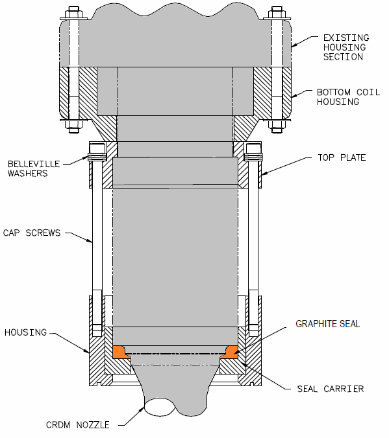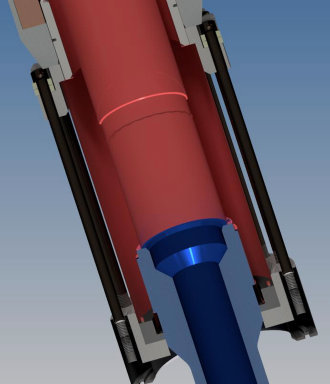
CSCA is a trademark or registered trademark of Westinghouse Electric Company, LLC.
Background
Small leaks in pressurized water reactor (PWR) head penetrations can prevent a nuclear power plant from returning to power and cause expensive delays until a fix is devised. An increasing number of plants are reporting primary coolant leaks in the field-welded canopy seal area. To control these kinds of leaks, Westinghouse offers a full range of products and services including a unique mechanical clamp assembly named the Canopy Seal Clamp Assembly (CSCA™).
Description
The canopy seal is a weld between the reactor vessel head control rod drive mechanism (CRDM) penetration and the mating part. This weld has a tendency to develop cracks as a result of stress corrosion cracking (SCC) and/or original weld defects. These cracks spread through the walls and create leakage.
The Westinghouse CSCA provides a non-welded mechanical method to stop leaks in the canopy seal weld. The CSCA seals the leaking weld and introduces a compressive load into the canopy seal, which tends to close and arrest the crack propagation. The CSCA seals the leaking weld by compressing a graphite seal over the entire canopy seal weld area.
The CSCA consists of a housing, a top plate, seal carrier halves, a split graphite seal, cap screws, and Belleville washers. The general arrangement is the same for spare capped CRDM penetrations, full-length active CRDM penetrations, and core exit thermocouple (CET) CRDM penetrations.
To be repaired, the housing is lowered over the penetration, below the elevation of the canopy seal weld. The first seal carrier half with graphite seal is lowered and placed into the housing; the second seal carrier half is installed the same way. The housing is then raised until the graphite seal contacts the canopy seal and the top plate, and the cap screws with the Belleville washers are installed to provide the necessary loading forces.

CAD Model of CSCA Installed
Deliverables
Trained Westinghouse crews will implement the installations with special tooling designed for this unique application. We provide full engineering and support services, including design specification, stress report, and certifications to Section III of the ASME Code.
At several plants, the installations were done on an emergency basis. In this situation, the CSCAs are installed and the leak is eliminated within four to five days after notification by the utility.
Benefits
- The average radiation dose for all installations was less than 300 millirem per CSCA, comparing favorably with about 1.5 man rem per penetration for weld overlay repairs, and up to 10 to 20 man rem per penetration for other "cut and cap" or welding options.
- CSCA installation can be done without draindown of the reactor cooling system ( a distinct advantage over weld repair options. A leak at one plant wasn't discovered until the outage was over and the unit was returned to power. The CSCA was installed with the RCS in Mode 5 at about 300 psi and at 170°F. At another plant, the CSCA was installed during a system heat up to about 200°F.
- The CSCA works on leaking or non leaking canopy seal welds, and can also be modified for installation on previously overlay repaired welds. Applying the CSCA on a non leaking seal weld is a good preventative measure against continued SCC, which is a primary cause of failure.
Experience
CSCAs have been installed on 41 reactors (179 CSCAs) in the U.S. and Europe since 1988 with an excellent performance record. No CSCAs have shown evidence of leakage after being installed.

Section View of CSCA CAD Model













